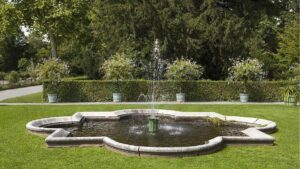- Product Knowledge
Chlorine or Bromine in Fountains?

Fountains are more than just decorative elements in landscapes; they add tranquility, ambiance, and a touch of elegance to any environment. However, maintaining the water quality in these features is essential for their beauty and functionality. Two popular sanitizers—chlorine and bromine—are often used to keep fountain water clean and free from harmful bacteria and algae. But which one is the better choice for your fountain? This guide will explore the pros and cons of each, helping you make an informed decision.
Understanding the Importance of Sanitizers in Water Features
Fountains are constantly exposed to the elements, making them susceptible to contamination from debris, organic material, and microorganisms. Without proper sanitation, the water in your fountain can quickly become a breeding ground for algae, bacteria, and other harmful pathogens. Not only does this affect the appearance and smell of the water, but it also poses potential health risks. Therefore, choosing an effective sanitizer is crucial to maintaining the cleanliness and safety of your water feature.
How Chlorine Works in Fountains
The Science Behind Chlorine as a Disinfectant
Chlorine is one of the most widely used disinfectants in water treatment, thanks to its powerful ability to kill bacteria, viruses, and algae. When added to water, chlorine reacts to form hypochlorous acid, which penetrates the cell walls of microorganisms and destroys them from within. This makes chlorine an efficient and reliable option for keeping fountain water clear and hygienic.
Benefits of Using Chlorine in Fountains
One of the main advantages of using chlorine is its effectiveness. It works quickly to eliminate contaminants and is relatively inexpensive, making it a popular choice for both residential and commercial water features. Chlorine is also easy to find in various forms, including tablets, granules, and liquid, providing flexibility in application.
Potential Drawbacks of Chlorine Use in Outdoor Water Features
Despite its effectiveness, chlorine has some drawbacks. It can be harsh on the skin and eyes, which might be a concern if your fountain is located in an area where people might come into contact with the water. Additionally, chlorine can be less effective in warmer water and may produce a strong odor, particularly if not used correctly. Over time, chlorine can also contribute to the corrosion of fountain materials, potentially shortening the lifespan of your water feature.
The Role of Bromine in Water Sanitation
Bromine: A Viable Alternative to Chlorine?
Bromine is another powerful sanitizer often used in water treatment, particularly in spas and hot tubs. Like chlorine, bromine works by breaking down the cell walls of microorganisms, but it does so in a different chemical process. This makes bromine an attractive alternative to chlorine, especially for those sensitive to chlorine’s effects.
Advantages of Using Bromine in Fountains
Superior Stability in Higher Temperatures
One of the significant advantages of bromine is its stability in warmer water. Unlike chlorine, bromine remains effective at higher temperatures, making it an excellent choice for fountains located in sunny or warm climates. Bromine also tends to be less irritating to the skin and eyes, providing a more comfortable experience for those who might come into contact with the water.
Gentler on Skin and Eyes
Bromine is known for being less harsh than chlorine, which can be especially beneficial if your fountain is in a public area or near a pool where people may touch the water. This gentler nature makes bromine a preferred option for fountains that are part of wellness or relaxation spaces.
Possible Disadvantages of Bromine in Water Treatment
However, bromine is not without its drawbacks. It is typically more expensive than chlorine, and while it is less harsh, it can still cause some irritation in sensitive individuals. Additionally, bromine can be harder to find in certain regions and might require more frequent testing and adjustment to maintain optimal levels.
Chlorine vs. Bromine: A Comparative Analysis
Effectiveness in Killing Bacteria and Algae
When it comes to effectiveness, both chlorine and bromine are highly efficient at killing bacteria and algae. However, chlorine may act faster, while bromine provides longer-lasting protection, especially in warmer water.
Cost Considerations: Which is More Economical?
Chlorine is generally more affordable, making it a popular choice for larger or multiple fountains. Bromine, though more expensive, might offer better value in environments where water temperature and comfort are significant considerations.
Impact on Fountain Materials: Corrosion and Longevity
Chlorine can be corrosive over time, especially if the water’s pH levels are not properly balanced. Bromine is less likely to cause corrosion, potentially extending the lifespan of your fountain’s components.
Environmental Impact: Which is More Eco-Friendly?
Chlorine and bromine both have environmental impacts, but bromine is often considered slightly more eco-friendly due to its stability and lower required dosage. However, both should be used carefully to minimize any adverse environmental effects.
Choosing the Right Sanitizer for Your Fountain
Assessing Your Fountain’s Specific Needs
Every fountain is different, and the right sanitizer will depend on various factors, including climate, water temperature, and the fountain’s location. For instance, fountains in warmer climates may benefit from bromine’s stability, while those in cooler areas might do well with chlorine.
Climate and Water Temperature
If your fountain is in a hot, sunny area, bromine’s ability to remain effective at higher temperatures could make it the better choice. In cooler climates, chlorine’s faster action might be more beneficial.
Usage Frequency and Maintenance Schedule
Consider how often your fountain is used and how much maintenance it requires. Chlorine might be more suitable for fountains that need frequent cleaning, while bromine could be ideal for those with a less demanding maintenance schedule.
Compatibility with Existing Fountain Systems
Before switching or choosing a sanitizer, check your fountain’s materials and filtration system to ensure compatibility. Some materials may respond better to one sanitizer over the other.
Personal Preferences: Sensory Experience and Health Considerations
Ultimately, personal preference plays a significant role. If you or others using the fountain are sensitive to chlorine, bromine may provide a more pleasant experience.
Both chlorine and bromine are effective sanitizers for fountains, each with its own set of advantages and disadvantages. Chlorine is cost-effective and powerful but can be harsh and corrosive over time. Bromine, while more expensive, offers greater stability in warm water and a gentler experience for those in contact with the water. By assessing your fountain’s specific needs and considering factors like climate, material compatibility, and personal preferences, you can choose the best sanitizer to keep your water feature clean, safe, and enjoyable for years to come.



